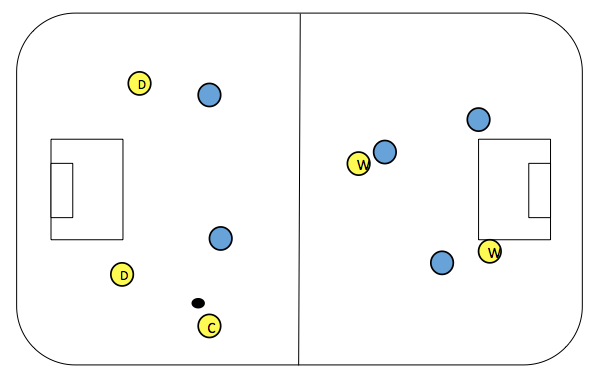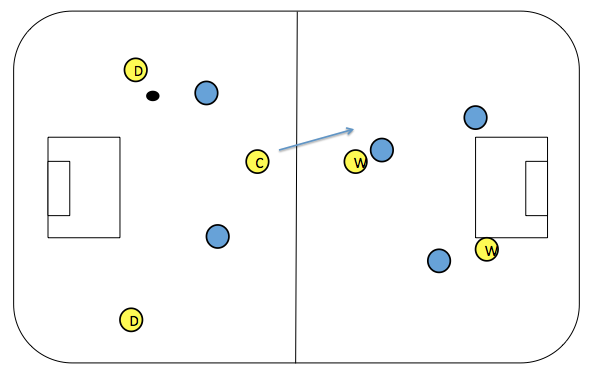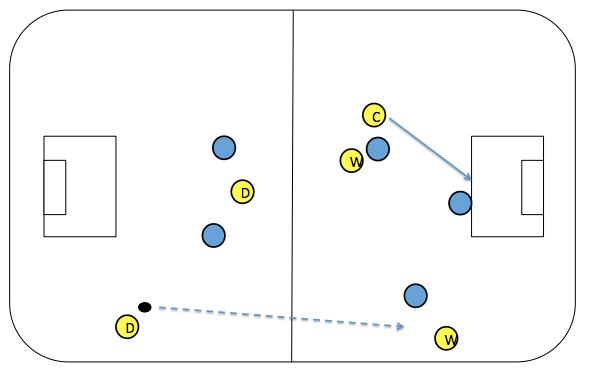After posting the analysis (SWE-FIN U19 Final), I started thinking that maybe the Sweden's coaching staff thought they had in fact organized at least their attacking build up -phase. After a further reflection it occured to me that yes, they probably had some plans after all (pictures below). When it comes to executing that plan however, they failed to help their players to succeed. Actually (and probably) on the contrary.

Picture 1: Sweden's center (C) started the play sometimes from the midline, other times straight from the right but the movements were as follows. Center starts a dribble to the middle, plays the ball to left defender.

Picture 2: The center continued his movement while at the same time, left defender (here with the ball) started his own dribble to the middle.

Picture 3: Left defender passed the ball to the right defender who tried to play direct long pass to the top winger. The center tried to time his run so that he would still be in playable position in relation to the top winger who is about to get the ball here.

Picture 4: The ball is traveling towards center who has been left open. The top winger had also a passing option to the other winger or to the upper defender.
These kind of build up ideas has been seen in Sweden's mens national team also but with more variability and flexibility.
Example 1: Sweden national team build up 1
Example 2: Sweden national team build up 2
Organizing and training a single set play does not equal organizing the offensive game. It may actually be even worse. There will always be some kind of organization on the field. If not coach led, then the players / lines will talk and agree on some basic principles: ”When I go here, you go there.” etc. The lines will then self-organize and while I do not encourage this at this level – the coach should lead the process because of numerous reasons – it will leave players room to adapt and be more flexible with their team play and decision-making. The players can then adapt, anticipate and react to what is actually happening on the field.
When Sweden’s coaching staff had drilled only one build up set play (with very mediocre results) and made the players execute that, the end result was very rigid system in which the players ran into trouble every time there was even a tiny drop in the quality and / or Finland’s line anticipated the set play and positioned themselves accordingly. It was like banging their head on the wall and repeating it about 60 minutes. And this is important – the players are not to blame as the coaching staff threw them on the field without helping them to play at their best. As they only had one* set play, the players were unable to do things in any given moment that the GAME asked them to do. They were put on the field to play the very rigid and poor system, not the game.
*There might have been more but those were not to be seen – you haven’t taught if they haven’t learned.
There is a big difference between rigid system and a flexible structure which takes into account the complexity of the game (middle in the picture below). As mentioned earlier, Sweden possibly would have played better if they had a player / individual led, totally free offensive system (left in the picture below). It would have been more flexible and the very talented players would have been able to adapt to Finland’s game. Now they had one rigid set play (right in the picture) with no room for players to adapt to their surroundings.

Picture 5 (source: https://methodkit.com/thoughts-behind/): Chaos with random connections (total freedom) on the left, complexity on the center where patterns and connections help players to connect with each other. On the right rigid system with no freedom to adapt.
This leads to the discussion about the preparation and the training process leading to the World Championships. If the coaches in any club / nation would really want to help their players to succeed in a complex system that is the game of floorball, they should start using nonlinear methods like constraints based approach/learning. This would affect the quality of team play in a holistic way and more directly.
That is a subject however that needs a post of its own.
